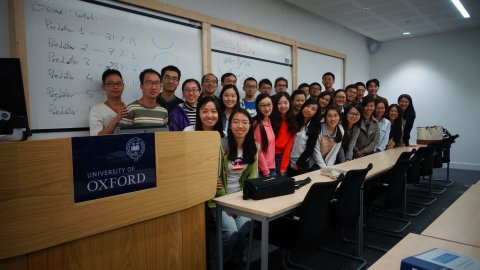Profinite presentations of finite groups
Abstract
There are many natural questions one can ask about presentations of finite groups- for instance, given two presentations of the same group with the same number of generators, must the number of relations also be equal? This question, and closely related ones, are unsolved. However if one asks the same question in the category of profinite groups, surprisingly strong properties hold- including a positive answer to the above question. I will make this statement precise and give the proof of this and similar results due to Alex Lubotzky.
12:00
DIVERGENCE-MEASURE FIELDS: GENERALIZATIONS OF GAUSS-GREEN FORMULA
Abstract
Divergence-measure fields are $L^{p}$-summable vector fields on $\mathbb{R}^{n}$ whose divergence is a Radon measure. Such vector fields form a new family of function spaces, which in a sense generalize the $BV$ fields, and were introduced at first by Anzellotti, before being rediscovered in the early 2000s by many authors for different purposes.
Chen and Frid were interested in the applications to the theory of systems of conservation laws with the Lax entropy condition and achieved a Gauss-Green formula for divergence-measure fields, for any $1 \le p \le \infty$, on open bounded sets with Lipschitz deformable boundary. We show in this talk that any Lipschitz domain is deformable.
Later, Chen, Torres and Ziemer extended this result to the sets of finite perimeter in the case $p = \infty$, showing in addition that the interior and exterior normal traces of the vector field are essentially bounded functions.
The Gauss-Green formula for $1 \le p \le \infty$ has been also studied by Silhavý on general open sets, and by Schuricht on compact sets. In such cases, the normal trace is not in general a summable function: it may even not be a measure, but just a distribution of order 1. However, we can show that such a trace is the limit of the integral of classical normal traces on (smooth) approximations of the integration domain.
Oxford Mathematics's Professor Andrew Wiles has been awarded the Copley Medal, the Royal Society's oldest and most prestigious award. The medal is awarded annually for outstanding achievements in research in any branch of science and alternates between the physical and biological sciences.
Finiteness properties and subdirect products of groups
Abstract
In my talk I will give a basic introduction to the finiteness properties of groups and their relation to subgroups of direct products of groups. I will explain the relation between such subgroups and fibre products of groups, and then proceed with a discussion of the n-(n+1)-(n+2)-Conjecture and the Virtual Surjections Conjecture. While both conjectures are still open in general, they are known to hold in special cases. I will explain how these results can be applied to prove that there are groups with arbitrary (non-)finiteness properties.
Robert Calderbank - the Art of Signaling
Abstract
Coding theory revolves around the question of what can be accomplished with only memory and redundancy. When we ask what enables the things that transmit and store information, we discover codes at work, connecting the world of geometry to the world of algorithms.
This talk will focus on those connections that link the real world of Euclidean geometry to the world of binary geometry that we associate with Hamming.
11:00
Zeta Functions and Definable Sets
Abstract
I will talk about a result on meromorphic continuation of Euler products over primes p of definable p-adic or motivic integrals, and applications to zeta functions of groups. If time permitting, I'll state an analogue for counting rational points of bounded height in some adelic homogeneous spac




